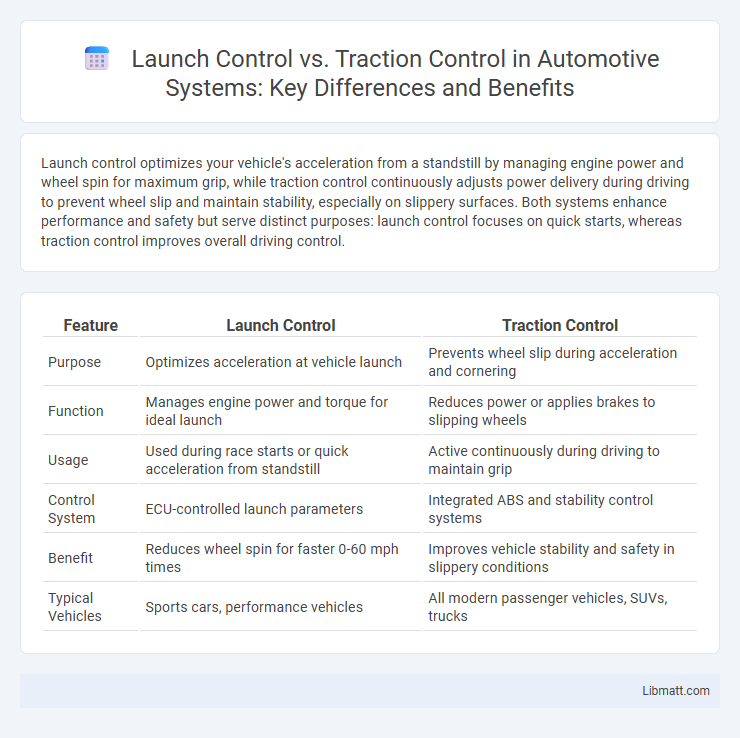Launch control optimizes your vehicle's acceleration from a standstill by managing engine power and wheel spin for maximum grip, while traction control continuously adjusts power delivery during driving to prevent wheel slip and maintain stability, especially on slippery surfaces. Both systems enhance performance and safety but serve distinct purposes: launch control focuses on quick starts, whereas traction control improves overall driving control.
Table of Comparison
| Feature | Launch Control | Traction Control |
|---|---|---|
| Purpose | Optimizes acceleration at vehicle launch | Prevents wheel slip during acceleration and cornering |
| Function | Manages engine power and torque for ideal launch | Reduces power or applies brakes to slipping wheels |
| Usage | Used during race starts or quick acceleration from standstill | Active continuously during driving to maintain grip |
| Control System | ECU-controlled launch parameters | Integrated ABS and stability control systems |
| Benefit | Reduces wheel spin for faster 0-60 mph times | Improves vehicle stability and safety in slippery conditions |
| Typical Vehicles | Sports cars, performance vehicles | All modern passenger vehicles, SUVs, trucks |
Introduction to Launch Control and Traction Control
Launch control optimizes vehicle acceleration from a standstill by managing engine power and clutch engagement for quicker, more controlled starts. Traction control enhances stability by preventing wheel spin during acceleration or cornering through selective braking and throttle adjustments. Both systems improve performance and safety but serve distinct functions in vehicle dynamics management.
Defining Launch Control: Purpose and Function
Launch control is a driver-assistance system designed to optimize acceleration from a standstill by managing engine power and wheel spin. It functions by electronically regulating throttle input and clutch engagement to deliver maximum traction and minimize wheel slip during rapid starts. This system enhances vehicle performance in competitive racing or high-performance driving scenarios by ensuring consistent and controlled launches.
Understanding Traction Control: Core Principles
Traction control systems use sensors to monitor wheel speed and prevent wheel spin by adjusting engine power and braking force, enhancing vehicle stability and safety. Launch control specifically manages power delivery during acceleration from a standstill, optimizing grip and reducing wheel slip for faster and smoother starts. Both systems rely on real-time data to maintain optimal traction, but traction control operates continuously during driving, while launch control activates primarily during initial acceleration.
Key Differences Between Launch Control and Traction Control
Launch control optimizes vehicle acceleration from a standstill by managing engine power and clutch engagement for maximum grip and minimal wheel spin during race starts. Traction control continuously monitors and adjusts power delivery to prevent wheel slip during dynamic driving conditions, improving stability and safety on various road surfaces. While launch control is primarily designed for performance in controlled launches, traction control provides ongoing assistance to maintain traction throughout driving.
Advantages of Launch Control Systems
Launch control systems optimize acceleration by managing engine power and clutch engagement, enabling faster and more consistent starts in high-performance vehicles. This technology reduces wheel spin and improves grip, enhancing vehicle stability and minimizing tire wear during rapid acceleration. Compared to traction control, launch control provides precise control over launch dynamics, making it ideal for competitive racing and performance driving scenarios.
Benefits of Traction Control Technology
Traction control technology enhances vehicle stability by preventing wheel spin during acceleration, especially on slippery surfaces, improving your safety and confidence while driving. It optimizes tire grip, leading to better handling and reduced risk of skidding or loss of control, particularly in adverse weather conditions. The system also helps preserve tire life by minimizing unnecessary wear from uncontrolled wheel spin.
How Launch Control Works in Modern Vehicles
Launch control in modern vehicles optimizes acceleration by managing engine power and clutch engagement to prevent wheel spin during rapid starts. Sensors monitor wheel speed, engine RPM, and traction conditions, allowing precise modulation of torque delivery for maximum grip. This system enhances performance by ensuring consistent and efficient launches, especially in high-performance and sports cars.
Traction Control: Integration with Vehicle Safety
Traction control systems are designed to enhance vehicle safety by preventing wheel slip during acceleration, especially on slippery or uneven surfaces, thus maintaining optimal grip and stability. Integrated with other safety technologies like electronic stability control (ESC) and anti-lock braking systems (ABS), traction control helps reduce the risk of skidding and loss of vehicle control. This seamless integration ensures better handling and safer driving conditions, particularly in adverse weather or challenging road environments.
Performance Impact: Launch Control vs Traction Control
Launch control optimizes vehicle acceleration by managing engine power and clutch engagement to achieve maximum grip from a standstill, significantly improving 0-60 mph times. Traction control continuously monitors wheel slip during dynamic driving conditions, adjusting power delivery to maintain stability and prevent wheel spin, enhancing cornering performance and safety. While launch control focuses on peak acceleration performance off the line, traction control provides ongoing stability and control, contributing to overall vehicle handling and safety.
Choosing the Right System for Your Driving Needs
Launch control optimizes acceleration from a standstill by managing engine power and wheel slip, ideal for drag racing and performance starts. Traction control continuously adjusts power delivery to maintain stability during various driving conditions, enhancing safety on slippery or uneven surfaces. Selecting the right system depends on your driving style and environment--launch control suits competitive, straight-line racing, while traction control benefits everyday driving and variable road conditions.
launch control vs traction control Infographic

 libmatt.com
libmatt.com